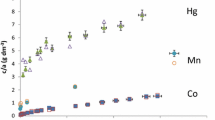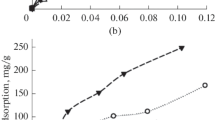Abstract
The pH, Eh, electrical conductivity (EC), and the amounts and valency of replaceable iron were measured periodically on Fe2+- and Fe3+-saturated montmorillonite and cation-exchange resin at three temperatures. Differences in the pattern of change of pH, Eh, and EC with time appear to be related more to the histories and modes of preparation of the systems than to intrinsic differences in the hydrolysis of the iron in them. Electron transfer reactions involving crystal components of the clay can cause oxidation of adsorbed Fe2+ ions; the activation energy (Ea) for oxidation on the clay’s surface was 6 kcal/mole, less than a third of the activation energy reported for Fe2+ oxidation in solution. In the Fe2+-resin, where Ea = 10.7 kcal/mole, perturbed surface-water molecules may act as electron acceptors enhancing Fe2+ oxidation.
Polymerization and precipitation of the adsorbed iron is affected by the necessity to maintain electro-neutrality, the ability of the iron-hydroxy ions and small polymers to move about in the voids of the ion exchanger, and the steric hindrance posed by the matrix of the ion exchanger to the formation of large polymers. In resin, little or no iron precipitates, probably due both to steric hindrance and the inability of the resin to release ionic components to maintain electroneutrality. In clays, steric hindrance is small, and Al and Mg are released from the crystal to maintain electroneutrality, thus the precipitation of iron is abundant and is controlled by the rate of release of Al and Mg from the crystal.
Резюме
Периодически замерялись рН, Eh, электрическая проводимость (ЭП), и количества и валентность замещаемого железа монтмориллонита и катионно-обменной смолы, насыщенных Fe2+ и Fe3+ при трех температурах. Различия в картине изменения рН, Eh, и ЭП в времени, по видимому, более связаны с предисториями и способами приготовления систем, чем с присущими различиями гидролиза железа в них. Реакции переноса электронов, включающие кристаллические компоненты глины, могут вызывать окисление адсорбированных ионов Fe2+; энергия активизации (ЭА) для окисления на поверхности глины равнялась 6 ккал/мол, меньше трети энергии активации, потребной для окисления Fe2+ в растворе. В Ре2+-смоле, где ЭА = 10,7 ккал/мол, возмущенные поверхностные молекулы воды могут действовать как электронные акценторы, помогая окислению Fe2+.
Полимеризация и осаждение адсорбированного железа находится под воздействием необходимости поддерживать электронную нейтральность, способность гидрокси-железных ионов и небольших полимеров передвигаться в полостях ионо-обменника, и пространственного препятствия, вызываемого кристаллической решеткой ионо-обменника, образованию больших полимеров. В смоле мало или вообще нет железных осадков, вероятно из-за пространственного препятствия и неспособности смолы высвобождать ионные компоненты для поддержания электронной нейтральности. В глинах пространственное препятствие незначительно, и Аl и Mg высвобождаются из кристалла для поддержания электронной нейтральности; в результате железо осаждается в изобилии и контролируется степенью высвобождения Аl и Mg из кристалла. [N.R.]
Resümee
Der pH, Eh, die elektrische Leitfähigkeit (EC), sowie die Mengen und Leitfähigkeit ersetzbaren Eisens wurde in gleichen Abständen an Fe2+- und Fe3+-gesättigten Montmorilloniten und an Kationen-austauschharzen gemessen. Unterschiede in der Art, wie sich pH, Eh, und EC im Laufe der Zeit ändern, scheinen mehr davon abzuhängen, wie die Systeme präpariert wurden, als von wirklichen Unterschieden bei der Hydrolyse des enthaltenen Eisens. Elektronenübergangsreaktionen, die Kristallbestandteile des Tons betreffen, können die Oxidation des adsorbierten Fe2+ verursachen; die Aktivierungsenergie (Ea) für die Oxidation an der Tonoberfläche betrug 6 Kcal/Mol, weniger als ein Drittel der Aktivierungsenergie, die für die Oxidation von Fe2+ in Lösung angegeben wird. Im Fe2+-IonenaustausChharz, mit einer Ea von 10,7 Kcal/Mol, Können gestörte Oberflächenwassermoleküle als Elektronenakzeptor wirken und die Oxidation von Fe2+ verstärken.
Die Polymerisation und Ausfällung des adsorbierten Eisens wird von folgenden Faktoren beeinflußt: von der notwendigen Erhaltung der Elektroneutralität, von der Fähigkeit der Eisenhydroxyionen und kleiner Polymere, in den Hohlräumen des Ionenaustauschers umherzuwandern und von sterischen Widerständen der Matrix des Ionenaustauschers gegen die Bildung großer Polymere. Im Ionenaustauschharz fällt wenig oder kein Eisen aus, wahrscheinlich sowohl wegen sterischer Widerstände als auch weil das Ionenaustauschharz keine Ionen abgeben kann, die die Elektroneutralität Aufrechterhielten. In Tonen ist der sterische Widerstand gering, und Al und Mg werden vom Kristall abgegeben, um die Elektroneutralität zu erhalten, sodaß die Eisenausfällung stark ist. Sie wird durch die Geschwindigkeit bestimmt, mit der Al und Mg vom Kristall abgegeben werden. [U.W.]
Résumé
Les pH, Eh, conductivité électrique (EC), et les quantités et la valence de fer remplaçeable ont été périodiquement mesurés sur une montmorillonite saturée en Fe2+ et Fe3+ et une résine à cation-échangeable à trois températures. Les différences dans le dessin de changements de pH, Eh, et EC avec le temps semblent être plus apparentées aux histoires et aux modes de préparation des systèmes qu’à des différences intrinsèques à l’hydrolyse du fer qu’ils contiennent. Les réactions de transfert d’électrons impliquant les composés cristaux de l’argile peuvent causer l’oxidation d’ions Fe2+ adsorbés; l’energie d’activation (Ea) pour l’oxidation à la surface de l’argile était 6 kcal/mole, moins qu’un tiers de l’énergie d’activation rapportée pour l’oxidation de Fe2+ en solution. Dans la résine-Fe2+, où Ea = 10.7 kcal/mole, des molécules d’eau de surface perturbées peuvent se comporter comme des acceptantes d’électrons favorisant l’oxidation de Fe2+.
La polymérisation et la précipitation du fer adsorbé sont affectées par la nécessité de maintenir l’électroneutralité, l’abilité des ions hydroxy-fer et des petits polymères de se mouvoir dans les vides de l’échangeur d’ions, et l’obstacle stérique posé par la matrice de l’échangeur d’ions à la formation de larges polymères. Dans la résine, peu ou pas de fer ne précipite, probablement à la fois à cause d’un obstacle stérique et de l’inabilité de la résine à lâcher des composés ioniques pour maintenir l’électroneutralité. Dans les argiles, l’obstacle stérique est petit, et Al et Mg sont lâchés du cristal pour maintenir l’électroneutralité, ainsi, la précipitation du fer est abondante et est contrôlée par l’allure de dégagement d’Al et de Mg du cristal. [D.J.]
Similar content being viewed by others
References
Banin, A. (1973) Quantitative ion exchange process for clays: U.S. Patent 3,725,528.
Banin, A. and Lahav, N. (1968) Particle size and optical properties of montmorillonite in suspensions: Isr. J. Chem. 6, 235–250.
Banin, A. and Ravikovitch, S. (1966) Kinetics of reactions in the conversion of Na- or Ca-saturated clay to H-Al clays: Clays & Clay Minerals 14, 193–204.
Barshard, I. and Kishk, F. M. (1970) Factors affecting K-fixation and CEC of soil vermiculite clay: Clays & Clay Minerals 18, 127–137.
Bio-Rad Laboratories (1969) Price List U., p. 12.
Brinkman, R. (1970) Ferrolysis, a hydromorphic soil forming process: Geoderma 3, 199–206.
Brownlow, C. E. A. (1962) Magnetic susceptibility measurements of Fe(III) form by ion exchange resin: Nature 194, 175–176.
Carstea, D. D. (1968) Formation of hydroxy-Al and Fe interlayers in montmorillonite and vermiculite: Influence of particle size and temperature: Clays & Clay Minerals 16, 231–238.
Carstea, D. D., Harward, M. E., and Knox, E. G. (1970) Comparison of Fe and Al hydroxy interlayers in montmorillonite and vermiculite: Soil Sci. Soc. Amer. Proc. 34, 517–526.
Chen, M. and Davidson, N. (1955) The kinetics of the oxygenation of ferrous iron in phosphoric acid solutions: J. Amer. Chem. Soc. 77, 793–798.
Fordham, A. W. (1969a) Sorption and precipitation of iron on kaolinite. I. Factors involved in sorption equilibria: Aust. J. Soil Res. 7, 185–197.
Fordham, A. W. (1969b) Sorption and precipitation of iron on kaolinite. II. Sorption isotherms and their interpretation in terms of iron(III) ionic equilibria: Aust. J. Soil Res. 7, 199–212.
Fortune, W. B. and Mellon, M. G. (1938) Determination of iron with o-phenantroline: Anal. Chem. 10, 60–64.
Gerstl, Z. (1974) Status and behavior of iron adsorbed on montmorillonite: M.Sc. Thesis, Hebrew University of Jerusalem, 83 pp., (English).
Gotoh, S. and Patrick, W. H., Jr. (1974) Transformation of iron in a waterlogged soil as influenced by redox potential and pH: Soil Sci. Soc. Amer. Proc. 38, 66–71.
Helfferich, F. (1962) Ion Exchange: McGraw-Hill, New York, 624 pp.
Herrera, R. and Peech, M. (1970) Reaction of montmorillonite with iron(III): Soil Sci. Soc. Amer. Proc. 34, 740–742.
Hsu, P. H. (1973) Appearance and stability of hydrolyzed Fe(ClO4)3 solutions: Clays & Clay Minerals 21, 267–278.
Hsu, P. H. and Ragone, S. E. (1972) Aging of hydrolyzed iron(III) solutions: J. Soil Sci. 23, 17–31.
Hudis, J. and Dodson, R. W. (1955) Rate of Fe+2-Fe+3 exchange in D2O: J. Amer. Chem. Soc. 78, 911–913.
Ismail, F. I. (1970) Oxidation-reduction mechanism of octahedral iron in mica type structures: Soil Sci. 110, 167–171.
Jackson, M. L. (1956) Soil Chemical Analysis, Advanced Course: published by the author, Univ. Wise, Madison, Wise, 991 pp.
Kawaguchi, K. and Kawachi, T. (1969) Cation exchange reactions in submerged soil. J. Sci. Soil Manure 40, 89–95.
Kunin, R. and Myers, R. J. (1950) Ion Exchange Resins: Wiley, New York, 212 pp.
Light, T. S. (1972) Standard solution for redox potential measurement: Anal. Chem. 44, 1038–1039.
Low, P. F. (1955) The role of aluminum in the titration of bentonite: Soil Sci. Soc. Amer. Proc. 19, 135–139.
Mackey, J. C. and Collins, R.L. (1967) The Mössbauer effect of Fe in ion exchange resins: J. Inorg. Nucl. Chem. 29, 655–660.
Mehra, O. P. and Jackson, M. L. (1960) Iron oxide removed from soils and clays by a dithionite-citrate system buffered with sodium bicarbonate: Clays & Clay Minerals 7, 317–327.
Meisal, W., Platschinda, A. S., and Susdalev, I. P. (1971) Mössbauer spectrometric studies on the forms of mordenite: Z. Anorg. Allg. Chem. 382, 188–194.
Murphy, P. J., Posner, A. M., and Quirk, J. P. (1975) Gel filtration chromotography of partially neutralized ferric solution. 1. Characterization of partially neutralized ferric nitrate solutions: J. Coll. Inst. Sci. 52, 229–238.
Ponnamperuma, F. N., Jianco, E. M., and Loy, T. (1967) Redox equilibria in flooded soils: I. The iron hydroxide systems: Soil Sci. 103, 374–382.
Raman, K. V. and Jackson, M. L. (1966) Layer charge relations in clay minerals of micaceous soils and sediments: Clays & Clay Minerals 14, 53–68.
Roth, C. E., Jackson, M. L., Lotse, E. G., and Syers, J. K. (1968) Fe+7Fe+3 ratio and CEC changes on deferration of weathered micaceous vermiculite: Isr. J. Chem. 6, 261–273.
Roth, C. E., Jackson, M. L., and Syers, J. K. (1969) Deferration effect on structural Fe+2/Fe+3 and CEC of vermiculites and soils: Clays & Clay Minerals 17, 253–264.
Rozenson, I. and Heller-Kallai, L. (1976) Reduction and oxidation of Fe3+ in dioctahedral smectites. 1. Reduction with hydrazine and dithionite: Clays & Clay Minerals 24, 271–282.
Rozenson, I. and Heller-Kallai, L. (1978) Reduction and oxidation of Fe3+ in dioctahedral smectites. 3. Oxidation of octahedral iron in montmorillonite: Clays & Clay Minerals 26, 88–92.
Solomon, D. H. (1968) Clay minerals as electron acceptors and/or electron donors in organic reactions: Clays & Clay Minerals 16, 31–39.
Stucki, J. W. and Roth, C. B. (1977) Oxidation-reduction mechanism for structural iron in nontronite: Soil Sci. Soc. Amer. J. 41, 808–814.
Stumm, W. and Morgan, J. J. (1970) Aquatic Chemistry: Wiley Interscience, New York, 583 pp.
Theng, B. K. G. (1971) Mechanisms of formation of colored clay-organic complexes: A review: Clays & Clay Minerals 19, 383–390.
Theng, B. K. G. and Walker, G. F. (1970) Interaction of clay minerals with organic monomers: Isr. J. Chem. 8, 417–424.
Thomas, G. W. and Coleman, N. T. (1964) The fate of exchangeable iron in acid systems: Soil Sci. 97, 229–232.
Turner, R. C. (1965) A study of the lime potentials. 4. The lime potential during titration of Wyoming Bentonite originally saturated with ferric ions: Soil Sci. 99, 88–92.
Whittig, L. D. and Page, A. L. (1961) Iron adsorption by montmorillonite systems: Soil Sci. Soc. Amer. Proc. 25, 278–281.
Author information
Authors and Affiliations
Rights and permissions
About this article
Cite this article
Gerstl, Z., Banin, A. Fe2+-Fe3+ Transformations in Clay and Resin Ion-Exchange Systems. Clays Clay Miner. 28, 335–345 (1980). https://doi.org/10.1346/CCMN.1980.0280503
Received:
Accepted:
Published:
Issue Date:
DOI: https://doi.org/10.1346/CCMN.1980.0280503




